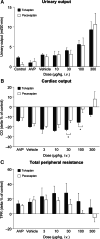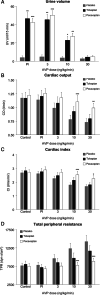Cardiac output improvement by pecavaptan: a novel dual-acting vasopressin V1a/V2 receptor antagonist in experimental heart failure
- PMID: 32946151
- PMCID: PMC8359415
- DOI: 10.1002/ejhf.2001
Cardiac output improvement by pecavaptan: a novel dual-acting vasopressin V1a/V2 receptor antagonist in experimental heart failure
Abstract
Aims: Arginine vasopressin (AVP) mediates deleterious effects via vascular V1a and renal V2 receptors in heart failure (HF). Despite positive short-term decongestive effects in phase II HF studies, selective V2 receptor antagonism has shown no long-term mortality benefit, potentially related to unopposed V1a receptor activation. We compared the novel dual V1a/V2 receptor antagonist pecavaptan with the selective V2 receptor antagonist tolvaptan in pre-clinical HF models.
Methods and results: In vitro IC50 determination in recombinant cell lines revealed similar receptor selectivity profiles (V2:V1a) of tolvaptan and pecavaptan for human and dog AVP receptors, respectively. Two canine models were used to compare haemodynamic and aquaretic effects: (i) anaesthetised dogs with tachypacing-induced HF, and (ii) conscious telemetric dogs with a non-invasive cardiac output (CO) monitor. Tolvaptan and pecavaptan exhibited no differences in urinary output. In HF dogs, pecavaptan counteracted the AVP-induced increase in afterload and decrease in CO (pecavaptan: 1.83 ± 0.31 L/min; vs. tolvaptan: 1.46 ± 0.07 L/min, P < 0.05). In conscious telemetric animals, pecavaptan led to a significant increase in CO (+0.26 ± 0.17 L/min, P = 0.0086 vs. placebo), in cardiac index (+0.58 ± 0.39 L/min/m2 , P = 0.009 vs. placebo) and a significant decrease in total peripheral resistance (-5348.6 ± 3601.3 dyn × s/cm5 , P < 0.0001 vs. placebo), whereas tolvaptan was without any significant effect.
Conclusions: Simultaneous blockade of vascular V1a and renal V2 receptors efficiently induces aquaresis and counteracts AVP-mediated haemodynamic aggravation in HF models. Dual V1a/V2 antagonism may lead to improved outcomes in HF.
Keywords: Animal model; Heart failure; Pecavaptan; V1a receptor; V2 receptor; Vasopressin antagonist.
© 2020 Bayer AG. European Journal of Heart Failure published by John Wiley & Sons Ltd on behalf of European Society of Cardiology.
Figures




Comment in
-
For vaptans, as for life, balance is better.Eur J Heart Fail. 2021 May;23(5):751-753. doi: 10.1002/ejhf.2042. Epub 2020 Nov 18. Eur J Heart Fail. 2021. PMID: 33125825 No abstract available.
References
-
- Gheorghiade M, Filippatos G, De Luca L, Burnett J. Congestion in acute heart failure syndromes: an essential target of evaluation and treatment. Am J Med 2006;119(12 Suppl 1):S3–S10. - PubMed
-
- Greene SJ, Fonarow GC, Vaduganathan M, Khan SS, Butler J, Gheorghiade M. The vulnerable phase after hospitalization for heart failure. Nat Rev Cardiol 2015;12:220–229. - PubMed
-
- Goldsmith SR, Gheorghiade M. Vasopressin antagonism in heart failure. J Am Coll Cardiol 2005;46:1785–1791. - PubMed
-
- Schrier RW, Gross P, Gheorghiade M, Berl T, Verbalis JG, Czerwiec FS, Orlandi C; SALT Investigators . Tolvaptan, a selective oral vasopressin V2‐receptor antagonist, for hyponatremia. N Engl J Med 2006;355:2099–2012. - PubMed
Publication types
MeSH terms
Substances
Grants and funding
LinkOut - more resources
Full Text Sources
Medical
Research Materials
Miscellaneous

